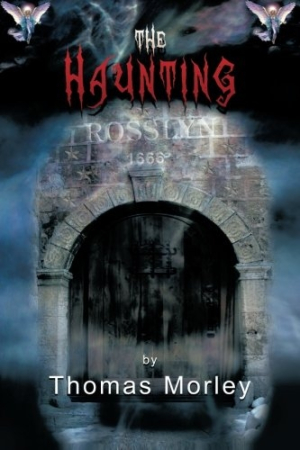The Haunting
The chilling cover of Thomas Morley’s potentially effective second book, The Haunting, invites ghost lovers to see what lurks within. Ethereal lettering hovers above the misty maw of a dark door. The haunting in mention happens to the Barrington family in their mansion in Merseyside, England.
Former Army officer Glen, his part-Romany wife Rosa, and their sons all adore each other. University student, musician, and martial arts master Tony promises to protect his family, especially his brother Luke. In October of 2009, Tony has a nightmare about a spectral attack. One year later, his dreams become reality.
However, this plot only accounts for fifty-five pages of this 158-page book. Just as the audience gets to know the characters, the author invites readers to “come away from the ongoing saga of the Barringtons” for “an excursion around this country with a little historical and factual data.” The data overwhelms as Morley gives a detailed history of the region, including the names of all the current schools and transport systems.
From there, Morley attempts to cover Rosslyn Chapel, Madame Blavatsky, spiritualism, chakras, and something called the Kundalini Serpent. The book switches from story to history and back again without warning. For example, the section called “History of the Gypsy/Roma” includes sentences about Rosa’s grandparents and her childhood, intermixed with the history of Gypsies as a group. Readers must remain alert for information about the Barringtons to appear when they least expect it. All this poorly connected information causes readers as much consternation as this sample does: “In my essay ‘The Secret Knowledge of Nibiru’ I described the possible connection between the Dark Star and the Eighth Sphere of the Theosophists.” Here, as in so many places, Morley knows whereof he speaks, but he does not take readers along with him.
The Barringtons’ story contains excessive sentence fragments and unnecessary superlatives. Here the author describes the relationship between Glen and Rosa: “There’s a saying (behind closed doors), private affairs, personal feelings, loving tenders, naked thrust, naked love, sensuous moments, erotic liaisons, the freedom of speech. Inhibitions discarded, set free. Emotions fulfilled, healed and soothed. Sexual healing. Responses to natural understanding. Caresses, affections, love. Sex yes, but love, always.” Suspense fails to build because needless details, such as a description of Tony’s stereo, are provided.
The ghost’s assault starts when two imps wring the necks of Luke’s doves and contemplate killing the boy. This scene is the creepiest in the book because of the direct dialogue between the demons before, during, and after they annihilate Luke’s pets. This scene illustrates the spirits’ gleeful cruelty, providing a welcome change from Morley’s usual telling and summary.
The ending stretches credibility. Tony’s martial arts skills defeat demons who have the power to start fires and render Glen mute. Glen calls the police to inform them that imps are assailing the family. The officer calmly responds, “This sounds a bit weird.” That sentiment sums up The Haunting, a ghost story that does not meet its potential.
Reviewed by
Jill Allen
Disclosure: This article is not an endorsement, but a review. The publisher of this book provided free copies of the book and paid a small fee to have their book reviewed by a professional reviewer. Foreword Reviews and Clarion Reviews make no guarantee that the publisher will receive a positive review. Foreword Magazine, Inc. is disclosing this in accordance with the Federal Trade Commission’s 16 CFR, Part 255.

